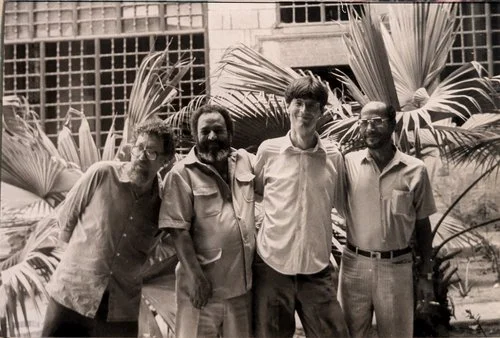
Zahran (middle left) with colleagues in the Musafir Khana courtyardMusafir Khana Palace (1770 - 1998)
Many gifted artists worked out of Musafir Khana Studio until the 1998 fire uprooted a generation of artists. Some of the names in this talented cohort include: Zahran Salama, Hosni Al-Banani, Mohammad Abla, Hamed Nada, Ezz El-Din Naguib, Adly Rezqallah and Ismail Diab.
The Musafir Khana Palace was built by Mahmood Muharram Al-Fayoomi throughout the 1770’s from profits trading goods, most likely coffee, between Cairo and the Hijaz. When Mahmood died in 1793, Mohammad Ali was quick to turn the palace into a home for his extended royal family. Consequently, the future Khedive of Egypt, Ismail Pasha, was born in Musafir Khana and spent years of his childhood running around the Ottoman era palace.
In the 1960’s, the Ministry of Culture - run by Tharwat Okasha - transformed the aged palace into a studio for Egypt’s finest artists. For nearly three decades, Musafir Khana was a highly productive workshop, where generational talent painted, sculpted, exhanged ideas, fought, mentored and - for one artist - even lived.
Research
Mohamad Kashef published his research “Musafirkhana Palace: The Lost Architectural Treasure” in November of 2010 with the goal of providing groundwork to reconstruction. The study also examines Musafir Khana within its surrounding urban context. Paper Link.
Sayed Hemeda and Tabina Osman published their research “Impacts of Fire on Historic Stone Masony Structures: Physicochemical Analysis and Application to the Al-Musafirkhana Palace (cairo)”. Paper Link.
On display at the Detroit Institute of Arts (DIA) is Frederick Arthur Bridgeman’s 1875 work titled Moorish Interior. The piece likely* depicts the Grand Mandara of Musafir Khana - which is Ottoman, not Moorish - but the misnomer may have been an acceptable generalization in Frederick’s day. The green arrow in Dr. Kashef’s map (below) shows the angle Frederick chose, giving the viewer a westward glimpse across the Grand Mandara and sliver of the staircase in the Takhtabush.
* Bridgeman travelled to Egypt in 1873-74 and produced hundreds of sketches during his travels that he would later reference for larger oil compositions when he returned to Paris. 